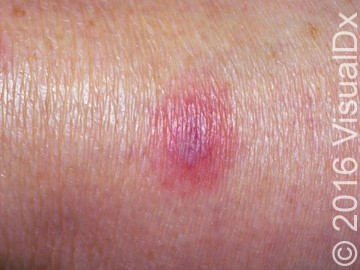Published on
The Resolution
Differential Diagnosis
- Aspergillosis
- Atypical mycobacterial infection
- Mucormycosis
- Candida sepsis

Diagnosis
This patient was diagnosed with aspergillosis, a hyaline mold found worldwide in decaying vegetation, soil, water, food, and plants. Inhalation of Aspergillus conidia is the most common mode of acquisition. Dissemination can lead to skin involvement, as well as central nervous system, liver, spleen, heart, and bone involvement.
Learnings/What to Look for
- Cutaneous aspergillosis begins with red papules that form pustules. The pustules ulcerate and leave a central eschar evocative of the diagnosis
- This is an indolent process that develops over months or years (hence it’s alternate name, chronic necrotizing aspergillosis)
- Many infectious and noninfectious etiologies are possible in immunocompromised patients with pulmonary nodules. Organisms to consider include Nocardia species, mycobacterial species, Legionella species, cryptococcal infection, and endemic fungi
- Septic emboli are possible, especially in patients with indwelling central venous catheters
Pearls for Urgent Care Management and Considerations for Transfer
- First-line treatment for aspergillosis is voriconazole. Other prescription antifungal medications used as second-line treatment include lipid amphotericin formulations, posaconazole, isavuconazole, itraconazole, caspofungin, and micafungin
Acknowledgment: Images courtesy of VisualDx (www.VisualDx.com/JUCM).
A 47-Year-Old Female Cancer Patient with Red, Flaccid Bullae on Her Leg
1 2
